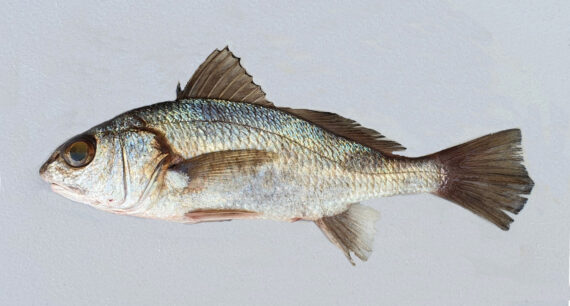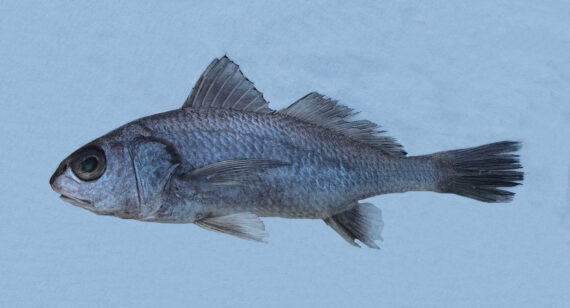Bigeye Croaker, Umbrina bussingi


 Bigeye Croaker, Umbrina bussingi. Fish caught from coastal waters off Los Barriles, Baja California Sur, June 2020. Length: 28 cm (11 inches). First photo is a freshly caught fish; second photo is of the same fish long frozen. Catch and first photograph courtesy of Chip Shapley, Los Barriles. Identification reconfirmed by H.J. Walker, Jr., Scripps Institution of Oceanography, La Jolla, California.
Bigeye Croaker, Umbrina bussingi. Fish caught from coastal waters off Los Barriles, Baja California Sur, June 2020. Length: 28 cm (11 inches). First photo is a freshly caught fish; second photo is of the same fish long frozen. Catch and first photograph courtesy of Chip Shapley, Los Barriles. Identification reconfirmed by H.J. Walker, Jr., Scripps Institution of Oceanography, La Jolla, California.
The Bigeye Croaker, Umbrina bussingi, is a member of the Croaker or Sciaenidae Family, that is also known as the Bigeye Drum and Bussing’s Drum and in Mexico as berrugata ojona. Globally, there are eighteen species in the Umbrina genus of which seven are found in Mexican waters, one in the Atlantic and six in the Pacific Ocean.
The Bigeye Croaker has a moderately elongated, somewhat compressed body with an oval cross-section and a body depth that is 29% to 33% of standard length and convex upper and lower body profiles. They have a uniform silvery-gray coloration with dusky fins. The inside of their gill chamber is very dark and visible through the gill cover. They have high arched backs. Their head is broad, conical, and low with a short projecting snout that has a slightly oblique mouth opening in the front and extending to the anterior of the pupil. They have disproportionally large eyes. Their gill covers are finely serrated. Their chin has 1 short thick rigid barbel with an elliptical pore at its tip and 2 pairs of pores at its base. Their teeth are set in bands on each jaw. Their anal fin has 2 spines, with a thick second spine that is almost as long as the first ray, and 7 rays that are small with a short base; the caudal fin is ”S” shaped or has angular point; the first dorsal fin has 10 slender spines, the fourth being the longest; the second dorsal fin has 1 spine and 21 to 23 rays and a long base; the pectoral fins have 17 to 18 rays and are long and pointed; and, their pelvic fins have 1 spine and 5 rays and originate below the pectoral fins. They have 17 to 22 gill rakers. They are covered with rough scales.
The Bigeye Croaker is a demersal species that is found over sandy substrate in deep waters at depths between 30 m (98 feet) and 185 m (600 feet). They reach a maximum of 39 cm (16 inches) in length. They consume mobile benthic worms, crustaceans, gastropods and bivalves. The Bigeye Croaker is poorly studied with very limited information available about their lifestyle and behavioral patterns including specific details on age, growth, longevity, movement patterns, diet, habitat use, and reproduction.
The Bigeye Croaker is a resident of Mexican waters of the Pacific but has a limited range, being found only in the extreme southeast portion of the Sea of Cortez in Baja California Sur and along the coast from Puerto Vallarta, Jalisco, south to Guatemala.
The Bigeye Croaker is most likely confused with the Surf Croaker, Umbrina xanti (stripes; smaller eyes; 25-30 dorsal rays; thinner body), and the Vacuoqua Croaker, Corvula macrops (lacks chin barbel; 9 to 11 anal fin rays).
From a conservation perspective the Bigeye Croaker is currently considered to be of Least Concern with stable, widely distributed populations. Due to their deep water and remote habitats they are seldom seen by humans.